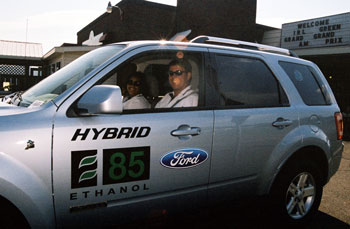 Hybrid and alternative fueled vehicles were in the spotlight July 6 at the Green Grand Prix in Watkins Glen, NY. The event is organized annually by the Seneca Lake Pure Waters Association, according to Executive Director Carol Fitzgerald.
Hybrid and alternative fueled vehicles were in the spotlight July 6 at the Green Grand Prix in Watkins Glen, NY. The event is organized annually by the Seneca Lake Pure Waters Association, according to Executive Director Carol Fitzgerald.
“This was our third annual Green Grand Prix and it was tremendously successful,” said Fitzgerald. “The goal of the event was to be able to create more awareness of alternative fuels and the impact they can have on the environment.”
There were a total of 36 different vehicles in the road rally this year representing 10 different fuel types.
“We had everything from hybrid vehicles, to the ethanol-powered vehicles, we had electric,” Fitzgerald said. “We actually even had a wood-chip powered vehicle.”
Representatives from the Ethanol Promotion and Information Council (EPIC) and the Renewable Fuels Association (RFA) participated in the road rally driving one of only 20 new 2007 Ford Escape Flex Fuel Hybrids currently being tested around the country.
RFA Communications Director Matt Hartwig and EPIC Communications Director Joanna Schroeder were able to average nearly 31 miles to the gallon in the Ford Escape, which is on loan to RFA from Ford to test drive.


 “This contract with the U.S. Department of Defense is another significant milestone for Syntroleum,” said Jack Holmes, CEO of Syntroleum. “When the contract is completed, we would be the first company to provide both renewable synthetic aviation fuel and FT aviation fuel to the Department of Defense for its certification and weapon system testing program. This acceptance of our alternative synthetic fuels once again validates the quality and integrity of our product, and the successful completion of this program will provide Syntroleum with an opportunity for other long-term supply contracts with the Department of Defense.”
“This contract with the U.S. Department of Defense is another significant milestone for Syntroleum,” said Jack Holmes, CEO of Syntroleum. “When the contract is completed, we would be the first company to provide both renewable synthetic aviation fuel and FT aviation fuel to the Department of Defense for its certification and weapon system testing program. This acceptance of our alternative synthetic fuels once again validates the quality and integrity of our product, and the successful completion of this program will provide Syntroleum with an opportunity for other long-term supply contracts with the Department of Defense.” The U.S. House Agriculture Committee is considering a measure that would allow U.S. growers to sell cane and beet sugar for making ethanol. It’s part of an 111-page proposal updating U.S. agriculture subsidies.
The U.S. House Agriculture Committee is considering a measure that would allow U.S. growers to sell cane and beet sugar for making ethanol. It’s part of an 111-page proposal updating U.S. agriculture subsidies. California-based Green Star Products, Inc. announced today that it has completed the second phase of testing its facility that turns algae into biodiesel.
California-based Green Star Products, Inc. announced today that it has completed the second phase of testing its facility that turns algae into biodiesel.  ‘The only way to stop reliance on ethanol would be to repeal its environmental benefits or to ban the use of ethanol altogether which would be very foolhardy,’ he told delegates at the International Conference on Biofuels here, adding that commodity prices would go up as a result.
‘The only way to stop reliance on ethanol would be to repeal its environmental benefits or to ban the use of ethanol altogether which would be very foolhardy,’ he told delegates at the International Conference on Biofuels here, adding that commodity prices would go up as a result. * DARYL HANNAH — The actress hopes to become a full time activist, campaigning on the environment and slavery. Hannah lives without mains electricity in the Rocky Mountains, using solar energy and driving a car run on biodiesel made from recycled cooking oil.
* DARYL HANNAH — The actress hopes to become a full time activist, campaigning on the environment and slavery. Hannah lives without mains electricity in the Rocky Mountains, using solar energy and driving a car run on biodiesel made from recycled cooking oil. * WILLIE NELSON — With Hannah and biodiesel producers Bob and Kelly King, the country singer helped set up the Sustainable Biofuels Alliance, bringing together activists and scientists to give consumers better guidance on clean fuels.
* WILLIE NELSON — With Hannah and biodiesel producers Bob and Kelly King, the country singer helped set up the Sustainable Biofuels Alliance, bringing together activists and scientists to give consumers better guidance on clean fuels. * SHERYL CROW — The singer travelled around U.S. colleges in April to raise awareness about global warming. Crow toured in a biodiesel-powered bus to university campuses with a final stop in Washington for Earth Day on April 22. Crowe and Karl Rove, political strategist to President George W. Bush, clashed over global warming at a White House dinner just after her tour.
* SHERYL CROW — The singer travelled around U.S. colleges in April to raise awareness about global warming. Crow toured in a biodiesel-powered bus to university campuses with a final stop in Washington for Earth Day on April 22. Crowe and Karl Rove, political strategist to President George W. Bush, clashed over global warming at a White House dinner just after her tour.